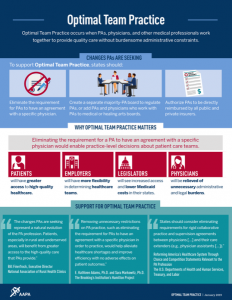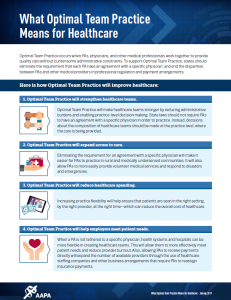Optimal Team Practice
What Is Optimal Team Practice?
Optimal Team Practice occurs when PAs, physicians, and other healthcare professionals work together to provide quality care without burdensome administrative constraints.
To support Optimal Team Practice, states should: eliminate the legal requirement for a specific relationship between a PA, physician, or any other healthcare provider in order for a PA to practice to the full extent of their education, training and experience; create a separate majority-PA board to regulate PAs or add PAs and physicians who work with PAs to medical or healing arts boards; and authorize PAs to be eligible for direct payment by all public and private insurers.
Want more resources on Optimal Team Practice? Join AAPA today!
Do you want to help advance the profession in your state? AAPA members can access additional Tools for State Advocates related to Optimal Team Practice. If you’re not a member, join now!
Optimal Team Practice FAQ
Read the FAQ below to learn more about Optimal Team Practice. Don’t see your question here? Email us!
Optimal Team Practice occurs when PAs, physicians, and other healthcare professionals work together to provide quality care without burdensome administrative constraints.
To support Optimal Team Practice, states should: eliminate the legal requirement for a specific relationship between a PA, physician or any other healthcare provider in order for a PA to practice to the full extent of their education, training and experience; create a separate majority-PA board to regulate PAs or add PAs and physicians who work with PAs to medical or healing arts boards; and authorize PAs to be eligible for direct payment by all public and private insurers.
Like every clinical provider, PAs are responsible for the care they provide. Nothing in the law should require or imply that a physician is responsible or liable for care provided by a PA, unless the PA is acting on the specific instructions of the physician.
The current legal requirement in nearly all states for a PA to have a specific relationship with a physician doesn’t align with current PA practice — or how healthcare is delivered to patients. “Specific relationship” represents a legal tether, which may come in the form of a practice agreement with a physician, or another type of arrangement, like the requirement for PAs to complete a form that designates a specific physician with whom they work. Regardless, any type of legal tether between a PA and another provider can be incredibly burdensome, not only for the provider but also on the health system or facility.
When a PA isn’t legally tethered to a physician, PA employers (health systems, hospitals, and group practices) can be more flexible in determining healthcare teams. This will allow them to more effectively meet patient needs. It will also make it easier for PAs to practice in medically underserved communities where there are not enough physicians (and, in some cases, no physicians) to care for patients. PAs would also be able to provide volunteer medical services and respond to disasters and emergencies —situations in which physicians might not be available or willing to enter into specific relationships with PAs, but immediate care is needed.
Allowing PAs to be eligible for direct payment will eliminate an important disparity between PAs and other providers, particularly nurse practitioners (NPs). Unlike physicians and advanced practice registered nurses (APRNs), which include NPs, PAs are not eligible for direct payment from Medicare and nearly all commercial insurance payers. Most payers require that payment be made to a PA’s employer, which can unintentionally limit PA employment opportunities with staffing companies and in certain practice arrangements, such as when hospitals contract with a group practice to provide services.
As the healthcare system continues its rapid transformation toward more innovative care models, PAs must have the same reimbursement flexibility enjoyed by other healthcare professionals, so they are not disadvantaged in the marketplace. Read more.
Today, physicians are regulated by state medical boards composed of physicians. Nurses are regulated by boards made up of nurses. Only PAs are regulated by boards that often have no members actively working in their own profession. This means the boards that regulate PA practice may lack knowledge of current PA practice or how rules and regulations may affect PA practice. This dearth of insight can lead to unnecessary restrictions and administrative burdens for PAs, physicians, and employers.
PAs deserve what physicians and nurses already have: regulatory boards with current knowledge about their profession. States can determine whether this is best accomplished by creating separate PA boards or by adding PAs and physicians who work with PAs to medical or healing arts boards. Read more.
Numerous studies have shown that PAs provide high-quality patient care and bring value to patients and PA employers. Currently, the retirement or sudden relocation, disability, or death of a physician with whom a PA has a legal relationship can mean the PA can no longer provide healthcare services to patients, even if the PA has been their primary care provider. Ultimately, when state laws and regulations remove the legal requirement for PAs to have a specific relationship with a physician, patients will have greater access to care, especially for medically underserved populations and patients in rural areas.
When a PA isn’t required to have a specific relationship with a physician, their employer can be more flexible in creating healthcare teams, allowing them to more effectively meet patient needs and reduce provider burnout. Ending this requirement also removes physician liability for the care that PAs provide when physicians are not involved and reduces physician and employer risk of disciplinary action for administrative reasons. Also, allowing PAs to receive payments directly will expand the number of available providers through the use of healthcare staffing companies and other business arrangements that require PAs to reassign insurance payments.
Physicians will benefit from these changes in many ways. First, when PAs are not required to have a specific relationship with a physician, physicians will no longer be responsible for care provided by the PA when the physician is not involved. This could substantially reduce physician exposure to liability.
Second, healthcare teams could be determined on a case-by-case basis at the practice level, allowing physicians to work with different PAs on different cases. Third, it would allow physicians to work with PAs more easily when they are employed in hospitals, health systems, and other corporate structures that use staffing companies. Currently, PAs are often prevented from participating in these staffing arrangements since, unlike NPs, they are not eligible for direct payment, and, therefore, cannot reassign their insurance reimbursements to the staffing company.
Absolutely. PA practice has been extensively studied and evaluated, and PAs have been found to provide high-quality patient care. Even under existing administratively burdensome laws and regulations, many — if not most — PAs have their own panels of patients and often serve as a patient’s primary healthcare provider. State laws and regulations have simply not kept pace with the changes in the healthcare marketplace or the changing needs of patients and PA employers.
Whether a PA is highly experienced, a new graduate, or changing the specialty area in which they work, they would continue to practice in teams with physicians, and their scope of practice would be determined at the practice level. If a patient’s condition falls outside of a PA’s training, education, and experience, a PA will still consult with other healthcare providers and make referrals when appropriate. If they don’t, that PA will be subject to disciplinary action by the state medical board, just as any other medical provider would be.
Under Optimal Team Practice, a newly licensed PA would, at their place of employment, be able to report to or be supervised by a physician, a senior PA, or a chief PA rather than having a specific relationship with a physician. Every PA and PA employer will continue to be responsible for assuring that there is adequate access to consultation and back-up. Removing the requirement for a specific relationship between a PA and a physician does not diminish those responsibilities.
The reality is that, in today’s healthcare environment, there is no such thing as “independent practice.” Gone are the days of the solo practitioner, working completely alone. Just like physicians, PAs will continue to collaborate with, consult with, and refer patients to other healthcare providers whenever the patient’s condition falls outside of their education, training, and experience. The PA profession’s commitment to team practice is powerful. The PA and physician who work together get to keep all the benefits of the team without the legal risks and administrative burdens that agreements entail. In addition, employers will have access to a wider range of providers and won’t have to file unnecessary administrative burden. Everyone wins.
Medicare policy says: “State law or regulation governing a PA’s scope of practice in the State where the services are performed applies.” However, the Current Medicare statute uses the word “supervision” to describe how physicians work with PAs. Medicare rules must also change as state laws describing team practice continue to evolve, moving away from the word and concept of “supervision.” AAPA has been advocating for this change. In the proposed 2020 Medicare Physician Fee Schedule, CMS proposes language that would modify Medicare’s existing physician supervision requirement to defer to state law regarding how PAs practice with physicians and other members of the healthcare team.

